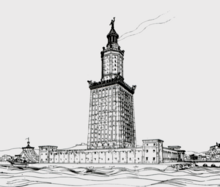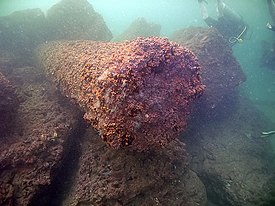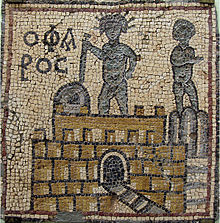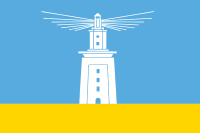Lighthouse of Alexandria
 From Wikipedia - Reading time: 21 min
From Wikipedia - Reading time: 21 min
 Drawing by archaeologist Hermann Thiersch (1909) | |
 | |
| Location | Pharos, Alexandria, Egypt |
|---|---|
| Coordinates | 31°12′53″N 29°53′10″E / 31.2148°N 29.886°E |
| Tower | |
| Constructed | between 284 and 246 BC |
| Foundation | Stone |
| Construction | Masonry |
| Height | 103 to 118 m (338 to 387 ft)[1] |
| Shape | Square (below), octagonal (middle) and cylindrical (top) |
| Light | |
| Deactivated | 1303 or 1323 |
| Range | 47 km (29 mi) |
The Lighthouse of Alexandria, sometimes called the Pharos of Alexandria (/ˈfɛərɒs/ FAIR-oss; Ancient Greek: ὁ Φάρος τῆς Ἀλεξανδρείας, romanized: ho Pháros tês Alexandreías, contemporary Koine Greek pronunciation: [ho pʰáros tɛ̂ːs aleksandrěːaːs]; Arabic: فنار الإسكندرية), was a lighthouse built by the Ptolemaic Kingdom of Ancient Egypt, during the reign of Ptolemy II Philadelphus (280–247 BC).[2] It has been estimated to have been at least 100 metres (330 ft) in overall height.[3] One of the Seven Wonders of the Ancient World, for many centuries it was one of the tallest man-made structures in the world.
The lighthouse was severely damaged by three earthquakes between 956 and 1323 AD and became an abandoned ruin. It was the third-longest surviving ancient wonder, after the Mausoleum at Halicarnassus and the extant Great Pyramid of Giza, surviving in part until 1480, when the last of its remnant stones were used to build the Citadel of Qaitbay on the site.
In 1994, a team of French archaeologists dived into the water of Alexandria's Eastern Harbour and discovered some remains of the lighthouse on the sea floor.[4] In 2016, the Ministry of State of Antiquities in Egypt had plans to turn submerged ruins of ancient Alexandria, including those of the Pharos, into an underwater museum.[5]
Origin
[edit]Pharos was a small island located on the western edge of the Nile Delta. In 332 BC, Alexander the Great founded the city of Alexandria on an isthmus opposite Pharos. Alexandria and Pharos were later connected by a mole[6] spanning more than 1,200 metres (0.75 miles), which was called the Heptastadion ("seven stadia"—a stadion was a Greek unit of length measuring approximately 180 m).
The east side of the mole became the Great Harbour, now an open bay; on the west side lay the port of Eunostos, with its inner basin Kibotos now vastly enlarged to form the modern harbour. Today's city development between the present Grand Square and the modern Ras el-Tin quarter is built on the silt which gradually widened and obliterated this mole. The Ras el-Tin promontory, where Ras el-Tin Palace was built in the 19th century, represents all that is left of the island of Pharos,[7] the site of the lighthouse at its eastern point having been weathered away by the sea.
Construction
[edit]
The lighthouse was constructed in the third century BC. After Alexander the Great died, Ptolemy the First (Ptolemy I Soter) declared himself king in 305 BC and commissioned its construction shortly thereafter. The building was finished during the reign of his son, Ptolemy II Philadelphus, and took twelve years to complete at a total cost of 800 talents of silver.[8] The light was produced by a furnace at the top, and the tower was said to have been built mostly with solid blocks of limestone and granite.[9]
In his encyclopedic manuscript Geographica, Strabo, who visited Alexandria in the late first century BC, reported that Sostratus of Cnidus had a dedication to the "Saviour Gods" inscribed in metal letters on the lighthouse. Writing in the first century AD, Pliny the Elder stated in his Natural History that Sostratus was the architect, although this conclusion is disputed.[10] In his second century AD educational treatise How to Write History, Lucian claimed that Sostratus hid his name under plaster which bore the name of Ptolemy, so that when the plaster eventually fell off, Sostratus's name would be visible in the stone.[11][12]
The blocks of sandstone and limestone used in the construction of the lighthouse have been scientifically analysed to discover where they originated, with mineralogical and chemical analysis pointing to the Wadi Hammamat quarries, in the desert to the east of Alexandria.[13]
Height and description
[edit]
Arab descriptions of the lighthouse are consistent despite it undergoing several repairs after earthquake damage. Given heights vary only fifteen percent from 103 to 118 m (338 to 387 ft), on a 30 by 30 m (98 by 98 ft) square base.[1]
The Arab authors indicate that the lighthouse was constructed from large blocks of light-coloured stone. The tower was made up of three tapering tiers: a lower square section with a central core; a middle octagonal section; and, at the top, a circular section.[14] Al-Masudi wrote in the 10th century that the seaward side featured an inscription dedicated to Zeus.[15] Geographer Al-Idrisi visited the lighthouse in 1154 and noted openings in the walls throughout the rectangular shaft with lead used as a filling agent in between the masonry blocks at the base. He reckoned the total height of the lighthouse to be 300 dhira rashashl (162 m).[16]
At its apex was a mirror which reflected sunlight during the day; a fire was lit at night. Extant Roman coins struck by the Alexandrian mint show that a statue of Triton was positioned on each of the building's four corners, and a statue of Poseidon or Zeus stood on top.[17]
The fullest description of the lighthouse comes from Arab traveller Abou Haggag Youssef Ibn Mohammed el-Balawi el-Andaloussi, who visited Alexandria in 1166.[18] Balawi provided a description and measurement of the interior of the lighthouse's rectangular shaft. The inner ramp was described as roofed with masonry at 7 shibr (189 cm, 6.2 ft), noted as to allow two horsemen to pass at once. In clockwise rotation, the ramp held four storeys with eighteen, fourteen, and seventeen rooms on the second, third, and fourth floors, respectively.[16]
Balawi reported the base of the lighthouse to be 45 ba (30 m, 100 ft) long on each side with connecting ramp 600 dhira (300 m, 984 ft) long by 20 dhira (10 m, 32 ft) wide. The octagonal section was 24 ba (16.4 m, 54 ft) in width, and the diameter of the cylindrical section 12.73 ba (8.7 m, 28.5 ft). The apex of the lighthouse's oratory was measured with diameter 6.4 ba (4.3 m 20.9 ft).[16]
Later accounts of the lighthouse after the destruction by the 1303 Crete earthquake include Ibn Battuta, a Moroccan scholar and explorer, who passed through Alexandria in 1326 and 1349. Battuta noted that the wrecked condition of the lighthouse was then only noticeable by the rectangle tower and entrance ramp. He stated the tower to be 140 shibr (30.8 m, 101 ft) on each side. Battuta detailed Sultan An-Nasir Muhammad's plan to build a new lighthouse near the site of the collapsed one, but these went unfulfilled after the Sultan's death in 1341.[16]
-
The lighthouse on coins minted in Alexandria in the second century AD (1: reverse of a coin of Antoninus Pius, and 2: reverse of a coin of Commodus)
-
A 3D reconstruction of the Lighthouse of Alexandria
Destruction
[edit]The lighthouse was partially cracked and damaged by earthquakes in 796 and 951, followed by structural collapse in the earthquake of 956, and then again in 1303 and 1323. Earthquakes propagate from two well known tectonic boundaries, the African–Arabian and Red Sea Rift zones, respectively 350 and 520 km from the lighthouse's location. Documentation shows the 956 earthquake to be the first to cause structural collapse of the top 20 metres of the construction.[19]
Documented repairs after the 956 earthquake include the installation of an Islamic-style dome after the collapse of the statue that previously topped the structure. The most destructive earthquake in 1303 had an estimated intensity of VIII+ originating from Crete (280–350 km from Alexandria).[20] The stubby remnant disappeared in 1480, when the Sultan of Egypt, Qaitbay, built a medieval fort on the larger platform of the lighthouse site using the fallen stone.
The 10th-century Arab writer al-Mas'udi reports a legendary tale of the lighthouse's destruction, according to which Caliph Abd al-Malik ibn Marwan (r. 705–715) the Byzantines sent a eunuch agent, who adopted Islam, gained the Caliph's confidence and secured permission to search for hidden treasure at the base of the lighthouse. The search was cunningly made in such a manner that the foundations were undermined, and the Pharos collapsed. The agent managed to escape in a ship waiting for him.[21]
Archaeological research and rediscovery
[edit]
Gaston Jondet made the first detailed description of the submerged ruins of the old port of Alexandria in 1916. He was followed by Raymond Weill in the same year, and by Sir Leopold Halliday Savile in 1940.[22][23]
In 1968, the lighthouse was rediscovered. UNESCO sponsored an expedition to send a team of marine archaeologists, led by Honor Frost, to the site. She confirmed the existence of ruins representing part of the lighthouse. Due to the lack of specialised archaeologists and the area becoming a military zone, exploration was put on hold.[24]
A team of French archaeologists led by Jean-Yves Empereur re-discovered the physical remains of the lighthouse in late 1994 on the floor of Alexandria's Eastern Harbour. He worked with cinematographer Asma el-Bakri who used a 35 mm camera to take the first underwater pictures of the scattered remains of collapsed columns and statues. Empereur's most significant findings consisted of blocks of granite 49–60 tonnes in mass often broken into multiple pieces, 30 sphinxes, 5 obelisks and columns with carvings dating back to Ramses II (1279–1213 BC).[25]
The cataloguing of over 3,300 pieces was completed by Empereur and his team at the end of 1995 using a combination of photography and mapping. Thirty-six pieces of Empereur's granite blocks and other discoveries have been restored and are on display in Alexandria museums.[25] Satellite imaging has revealed further remains. In the early 1990s, the underwater archaeologist Franck Goddio began exploration at the opposite side of the harbour from where Empereur's team had worked.[26]
Satellite and sonar imaging has revealed the additional remains of wharves, houses and temples[26] which had all fallen into the Mediterranean as a result of earthquakes and other natural disasters.[27] It is possible to go diving and see the ruins. In 2012 the secretariat of the UNESCO Convention on the Protection of the Underwater Cultural Heritage was working with the Government of Egypt on an initiative to add the Bay of Alexandria (including the remains of the lighthouse) to a World Heritage List of submerged cultural sites.[28]
Significance
[edit]
Legend has it that the people of the island of Pharos were wreckers; hence, Ptolemy I Soter had the lighthouse built to help guide ships into port at night.[29]
The etymology of "Pharos" is uncertain. The word became generalised in modern Greek to mean "lighthouse" (φάρος 'fáros'), and was borrowed by many Romance languages such as French (phare), Italian and Spanish (faro) – and thence into Esperanto (faro) – Catalan, Romanian (far) and Portuguese (farol), and even some Slavic languages like Bulgarian (far). In French, Portuguese, Turkish, Serbian and Russian, a derived word means "headlight" (phare, farol, far, фар, фара).
Proposed reconstruction
[edit]Since 1978 proposals have been made to replace the lighthouse with a modern reconstruction. In 2015, the Egyptian government and the Alexandria governorate suggested building a skyscraper on the site of the lighthouse as part of the regeneration of the eastern harbour of Alexandria Port.[30]
Pharos in culture
[edit]The lighthouse remains a civic symbol of the city of Alexandria and of the Alexandria Governorate with which the city is more or less coterminous. A stylised representation of the lighthouse appears on the flag and seal of the Governorate and on many public services of the city, including the seal of Alexandria University.
In architecture
[edit]- A well-preserved ancient tomb in the town of Abusir, 48 kilometres (30 mi) southwest of Alexandria, is thought to be a scaled-down model of the Alexandria Pharos. Known colloquially under various names – the Pharos of Abusir, the Abusir funerary monument and Burg al-Arab (Arab's Tower) – it consists of a 3-storey tower, approximately 20 metres (66 ft) in height, with a square base, an octagonal midsection and cylindrical upper section, like the building upon which it was apparently modelled. It dates to the reign of Ptolemy II (285–246 BC), and is therefore likely to have been built at about the same time as the Alexandria Pharos.
- The design of minarets in many early Egyptian Islamic mosques followed a three-stage design similar to that of the Pharos, attesting to the building's broader architectural influence.[31]
- The George Washington Masonic National Memorial, located in Alexandria, Virginia, is fashioned after the ancient Lighthouse.[32]
- A fictionalized version of the structure – known as the "Pharos Lighthouse" – serves as the park icon, centerpiece, and identifier of Universal Islands of Adventure theme park, opened in 1999 at the Universal Orlando Resort. The real, functioning lighthouse resides in the park's Port of Entry area.[citation needed]
In literature
[edit]- Julius Caesar, in his Civil Wars (Part III, 111–112), describes the Pharos and its strategic importance. Gaining control of the lighthouse helped him subdue Ptolemy XIII's armies (48 BC):
Now because of the narrowness of the strait there can be no access by ship to the harbour without the consent of those who hold the Pharos. In view of this, Caesar took the precaution of landing his troops while the enemy was preoccupied with fighting, seized the Pharos and posted a garrison there. The result was that safe access was secured for his corn supplies and reinforcements.[33]
— Caesar, .civ.; or Anon.,.Alex
- The Romano-Jewish historian Josephus (37 – c. 100 AD) describes it in his book The Jewish War (4.10.5) when he gives a geographical overview of Egypt.
- It was described in the Zhu fan zhi ("Records of Foreign Peoples") by Zhao Rugua (1170–1228), a Chinese customs inspector for the southern port city of Quanzhou during the Song dynasty.[34]
- Ibn Battuta visited the lighthouse in 1326, finding "one of its faces in ruins," yet he could enter and noted a place for the guardian of the lighthouse to sit and many other chambers. When he returned in 1349, he "found that it had fallen into so ruinous a condition that it was impossible to enter it or to climb up to the doorway".[35]
Other
[edit]- In classical antiquity, an annual Jewish festival was held on the island of Pharos to honour the translation of the Jewish Scriptures into Greek, traditionally believed to have been completed there under Ptolemy II. On this occasion, a large Jewish crowd, along with some non-Jewish visitors, would gather on the beach for a grand picnic. Jewish philosopher Philo of Alexandria (c. 20 BCE – c. 50 CE) shed light on the site's symbolism, writing that the Jews honoured "the place where the light of that translation first shone out," expressing gratitude to God for this gift.[36]
- Pharos, the largest known impact crater and only named surface feature on Neptune's moon Proteus, is named after the island of Pharos.[37]
-
Flag of the Alexandria Governorate, featuring the lighthouse
-
The lighthouse as depicted in the Book of Wonders, a late 14th-century Arabic text
-
The Pharos of Abusir, an ancient funerary monument thought to be modelled after the Pharos at Alexandria, with which it is approximately contemporaneous
See also
[edit]- List of tallest structures built before the 20th century
- Minar (Firuzabad)
- Tower of Hercules, a Roman lighthouse in Spain
References
[edit]Notes
- ^ a b McKenzie, Judith (2011). The Architecture of Alexandria and Egypt: 300 BC – AD 700. Yale University Press. p. 42. ISBN 978-0300170948.
- ^ Clayton, Peter A. (2013). "Chapter 7: The Pharos at Alexandria". In Peter A. Clayton; Martin J. Price (eds.). The Seven Wonders of the Ancient World. London: Routledge. p. 11. ISBN 9781135629281.
- ^ Clayton, Peter A. (2013). "Chapter 7: The Pharos at Alexandria". In Peter A. Clayton; Martin J. Price (eds.). The Seven Wonders of the Ancient World. London: Routledge. p. 147. ISBN 9781135629281.
- ^ "Treasures of the Sunken City". Nova. Season 24. Episode 14. November 18, 1997. PBS. Transcript. Retrieved March 5, 2012.
- ^ "Sunken Ruins of Alexandria Will Be World's First Underwater Museum". Earthables. Archived from the original on March 10, 2016. Retrieved March 27, 2016.
- ^ Smith, Sir William (1952). Everyman's Smaller Classical Dictionary. J. M. Dent & Sons Ltd. p. 222.
- ^ Haag, Michael (2008). Vintage Alexandria: Photographs of the City, 1860–1960. American University in Cairo Press. p. 113. ISBN 9789774161926.
- ^ Over twenty-three tons of silver. "This was an enormous sum, a tenth of the treasury when Ptolemy I assumed the throne. (In comparison, the Parthenon is estimated to have cost at least 469 talents of silver.)"[1]
- ^ Cartwright, Mark. "Lighthouse of Alexandria". World History Encyclopedia. Retrieved November 10, 2020.
- ^ Tomlinson, Richard Allan (1992). From Mycenae to Constantinople: the evolution of the ancient city. Routledge. pp. 104–105. ISBN 978-0-415-05998-5.
- ^ Mckenzie, Judith (2007). Architecture of Alexandria and Egypt 300 B.C. A.D 700. Yale University Press. p. 41. ISBN 978-0-300-11555-0.
- ^ Lucian How to Write History, LXII
After he [Sostratus] had built the work he wrote his name on the masonry inside, covered it with gypsum, and having hidden it inscribed the name of the reigning king. He knew, as actually happened, that in a very short time the letters would fall away with the plaster and there would be revealed: 'Sostratus of Cnidos, the son of Dexiphanes, to the Divine Saviours, for the sake of them that sail at sea.' Thus, not even he had regard for the immediate moment or his own brief lifetime: he looked to our day and eternity, as long as the tower shall stand and his skill abide. History then should be written in that spirit, with truthfulness and an eye to future expectations rather than with adulation and a view to the pleasure of present praise.
- ^ "Characterization and Source of Sedimentary Rocks of the Alexandria Lighthouse Archaeological Objects, Egypt". ResearchGate. Retrieved November 10, 2020.
- ^ "lighthouse of Alexandria | History, Location, & Facts". Encyclopedia Britannica. Retrieved June 4, 2021.
- ^ Paul Jordan (2014). Seven Wonders of the Ancient World. Routledge. p. 44. ISBN 978-1-317-86885-9.
- ^ a b c d Behrens-Abouseif, Doris (January 1, 2006). "The Islamic History of the Lighthouse of Alexandria". Muqarnas Online. 23 (1): 1–14. doi:10.1163/22118993-90000093. ISSN 0732-2992.
- ^ Haas 1997, p. 144.
- ^ Clayton & Price 1988, p. 153.
- ^ Abdelnaby, Adel E.; Elnashai, Amr S. (October 2013). "Integrity assessment of the Pharos of Alexandria during the 1303 CE earthquake". Engineering Failure Analysis. 33: 119–138. doi:10.1016/j.engfailanal.2013.04.013.
- ^ Abdelnaby, Adel E.; Elnashai, Amr S. (October 2013). "Integrity assessment of the Pharos of Alexandria during the 1303 CE earthquake". Engineering Failure Analysis. 33: 119–138. doi:10.1016/j.engfailanal.2013.04.013.
- ^ Eickhoff 1966, p. 40.
- ^ Alexandria Pharos island
- ^ The Nile River Delta Coast and Alexandria Seaport, Egypt: A Brief Overview of History, Problems, and Mitigation
- ^ Frost, H. (2000). From Byblos to Pharos: some archaeological considerations. In N. Grimal, M. H. Mostafa, & D. Nakashima (Authors), Underwater archaeology and coastal management: Focus on Alexandria (pp. 64–68). Paris: UNESCO.
- ^ a b Lawler, Andrew. "Raising Alexandria". Smithsonian. Retrieved April 29, 2019.
- ^ a b Franck Goddio's Excavations in Alexandria Archived September 27, 2021, at the Wayback Machine
- ^ Boukhari, Sophie (February 1997). "Swimming With Sphinxes". UNESCO. 87.
- ^ "Museums and Tourism – United Nations Educational, Scientific and Cultural Organization". unesco.org. Archived from the original on November 10, 2012.
- ^ Clayton, Price, & Price, Martin. (1988). The seven wonders of the ancient world. London; New York: Routledge.
- ^ Amro Ali (July 7, 2015). "A frightening vision: on plans to rebuild the Alexandria Lighthouse". openDemocracy. Archived from the original on June 12, 2018. Retrieved July 14, 2017.
- ^ Petersen, Andrew (1996). Dictionary of Islamic Architecture. Routledge. p. 188. ISBN 9781134613663.
- ^ "*Ferris, Gary W. Presidential Places: A Guide to the Historic Sites of U.S. Presidents. Winston-Salem, N.C.: J.F. Blair, 1999. p.21"
- ^ It was common for Caesar in his writings to refer to himself in the third person.
- ^ Needham, Joseph (1986). Science and Civilization in China: Volume 5, Physics and Physical Technology, Part 3: Civil Engineering and Nautics. Taipei: Caves Books, Ltd. p. 662.
- ^ Battutah, Ibn (2002). The Travels of Ibn Battutah. London: Picador. pp. 6–7. ISBN 9780330418799.
- ^ Barclay, John M. G. (1998). Jews in the Mediterranean Diaspora: from Alexander to Trajan (323 BCE–117 CE). Edinburgh: T&T Clark. p. 424. ISBN 978-0-567-08651-8.
- ^ "Planetary Names: Crater, craters: Pharos on Proteus". Gazetteer of Planetary Nomenclature. USGS Astrogeology. Retrieved November 4, 2021.
Bibliography
- Al-Bakri; Dozy, Rheinhart P.A.; Goeje, Michael J. de (1866). Description de l'Afrique et de l'Espagne, (Description of Africa and Spain). Leyde, E.J. Brill.
- Clarie, Thomas C. (2009). Pharos – A Lighthouse For Alexandria. Back Channel. ISBN 978-1-934-58212-1.
- Clayton, Peter; Price, Martin (1988). The Seven Wonders of the Ancient World. Dorset. ISBN 0-880-29393-4.
- Eickhoff, Ekkehard (1966). Seekrieg und Seepolitik zwischen Islam und Abendland: das Mittelmeer unter byzantinischer und arabischer Hegemonie (650-1040) (in German). De Gruyter.
- Haas, Christopher (1997). Alexandria in Late Antiquity: Topography and Social Conflict. Johns Hopkins. ISBN 0-8018-8541-8.
- Levi-Provençal, Évariste (1935). Une Description Arabe Inédite du Phare d'Alexandrie,(An Unpublished Description of the Lighthouse of Alexandria), extract from Mémoires de l'Institut Francais. unpublished.
- Trethewey, Ken (2018). Ancient Lighthouses. UK. ISBN 978-0-9926573-6-9.
Further reading
[edit]- Harris, William V., and Giovanni Ruffini (2004). Ancient Alexandria Between Egypt and Greece. Leiden: Brill.
- Higgins, Michael Denis (2023). The Seven Wonders of the Ancient World: Science, Engineering and Technology. New York, NY: Oxford University Press. ISBN 9780197648155.
- Jordan, Paul (2002). The Seven Wonders of the Ancient World. Harlow: Longman.
- Polyzōidēs, Apostolos (2014). Alexandria: City of Gifts and Sorrows: From Hellenistic Civilization to Multiethnic Metropolis. Chicago: Sussex Academic Press, 2014.
- Thompson, Alice (2002). Pharos. London: Virago.
- Tkaczow, Barbara, and Iwona Zych (1993). The Topography of Ancient Alexandria: An Archaeological Map. Warszawa: Zaklad Archeologii Śródziemnomorskiej, Polskiej Akadmii Nauk.
 KSF
KSF





